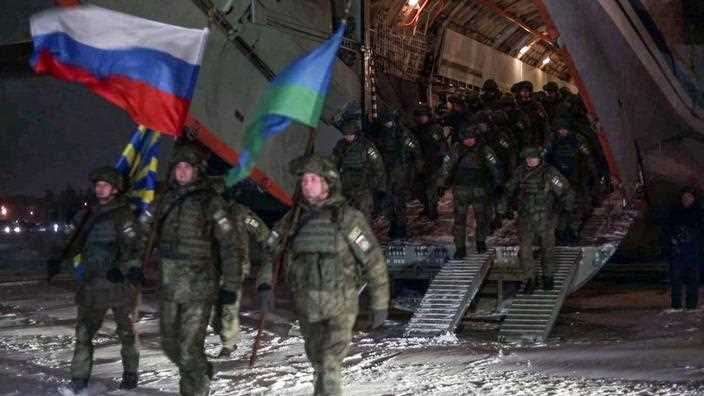The Russian armed forces and their allies completed their withdrawal from Kazakhstan on Wednesday, January 19, after their deployment aimed at supporting power in this authoritarian country in Central Asia, threatened in early January by deadly riots.
Read alsoRussian-led forces begin withdrawal from Kazakhstan
More than 2,000 soldiers had been dispatched to the former Soviet republic at the request of President Kassym-Jomart Tokayev following violence not seen since the country’s independence in 1991. In early January, demonstrations against an increase in the price of oil energy had degenerated into riots and armed repression, killing more than 200 people, injuring hundreds and provoking at least 12,000 arrests.
“The peacekeeping operation is over”
“The peacekeeping operation (…) on the territory of the Republic of Kazakhstan is completed“, declared General Andreï Serdioukov, at the head of this mission of the Collective Security Treaty Organization (CSTO), a military alliance led by Moscow. The Russian Ministry of Defense clarified that “four planes of the Russian military transport aviation with peacekeepers took off from Nur-Sultan and Almaty airportsin Kazakhstan. These troops did not take part in the fighting between rioters and Kazakh forces, but their dispatch signified the political and military support of Vladimir Putin’s Russia for the regime in place.
The state of emergency instituted in the wake of protests and riots also ended on Wednesday, with presidential spokesman Berik Ouali writing on Facebook that “the unity and integrity of the people, law enforcement and militaryhad allowed the restoration of order in the country. Authorities blamed the violence on “terrorists“, trained abroad, a version which made it possible to call for the rescue the Russian soldiers and the CSTO, which counts, in addition to Russia, Armenia, Belarus, Tajikistan, Kyrgyzstan and Kazakhstan. The contingent, dispatched on January 6 in this former Soviet republic of Central Asia at the invitation of its president included 2030 Russian, Belarusian, Armenian, Tajik and Kyrgyz troops. The withdrawal began on January 13.
Access to several central streets blocked
In the streets of Almaty, the country’s largest city, AFP journalists found on Wednesday that police were still blocking access to several central streets after a banned opposition group called for protests. The events that bloodied Kazakhstan remain very opaque, with signs of an internal struggle at the top of power. On Tuesday, the influentialnation leader“, the former president Noursultan Nazarbayev, spoke for the first time since the beginning of the crisis to pledge allegiance to the current president.
After nearly two weeks of silence, 81-year-old Nursultan Nazarbayev claimed to be in the capital Nur-Sultan (renamed in his honor), but it is unclear when his speech was recorded. He assured that his successor Kassym-Jomart Tokayev, to whom he handed over the presidency in 2019, had “all powers“. “There is therefore no conflict or confrontation within the elite“, he added, denouncing “baseless rumors“. During the riots in early January, the anger of the protesters was particularly directed against Noursultan Nazarbayev, accused of having encouraged corruption in this former Soviet republic, which he led for three decades. Several of his relatives have been dismissed from key positions in recent days, and others have been imprisoned.
Read alsoKazakhstan president targets Nazarbayev empire
The violence in early January was the most serious in Kazakhstan since the country’s independence in 1991. The official death toll is 225 and the authorities have also reported some 12,000 arrests. The Kazakh government claimed that the attackers piloted from abroad had instrumentalized the social movement against the high cost of living but did not provide evidence as to the nature “terrorist” riots. The most serious violence took place in Almaty with exchanges of fire, the looting of shops and the burning of the town hall and the presidential residence.
